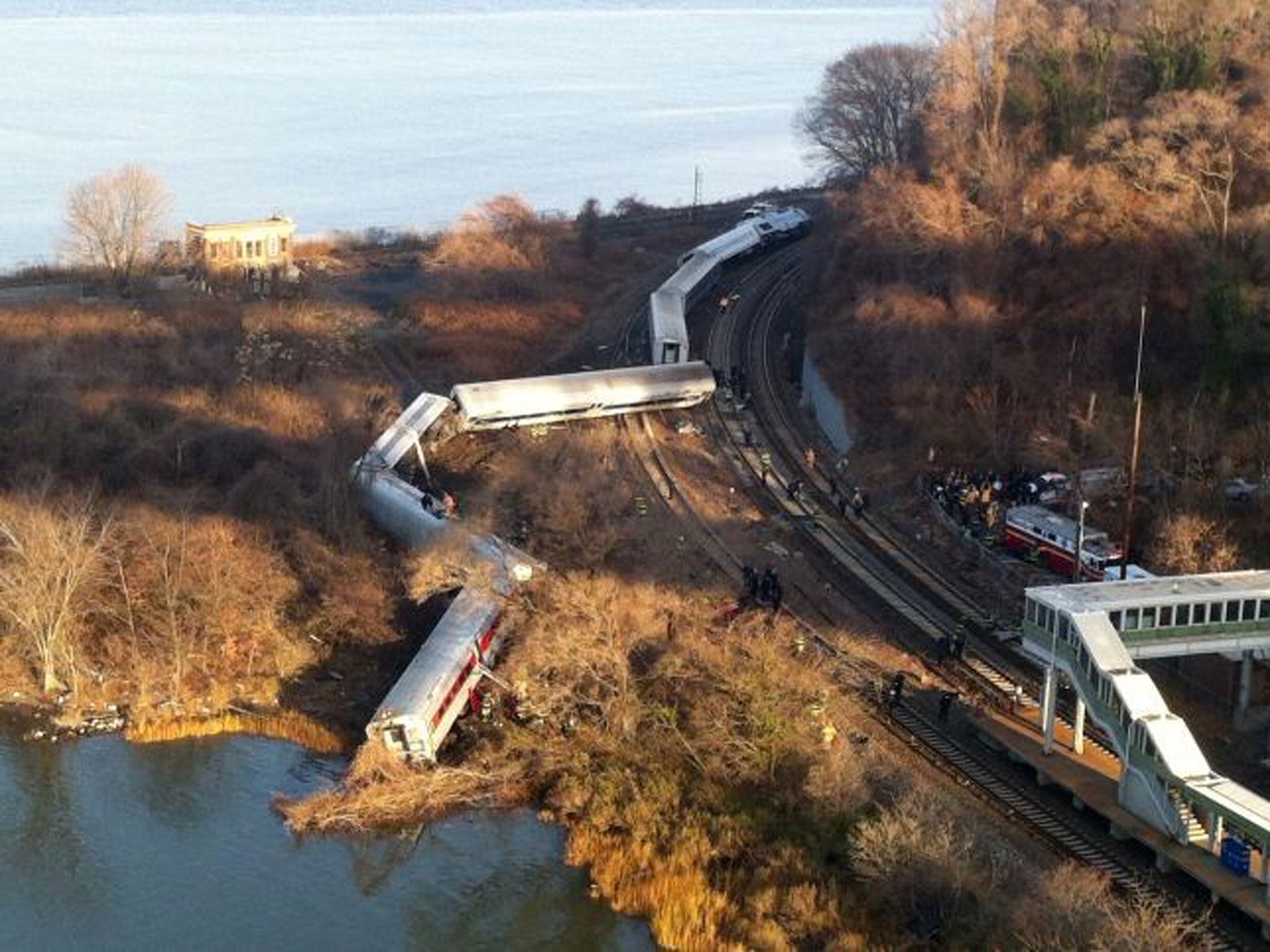Metro-North derailment: New York commuter train was travelling at 82mph on 30mph bend before crashing in the Bronx, killing four people
Federal investigators unclear whether accident was the result of human error or mechanical trouble

A New York commuter train that derailed over the weekend killing four people was travelling at 82mph as it entered a 30mph bend, federal investigators have revealed.
Safety experts said the tragedy might have been prevented if Metro-North Railroad had installed automated crash-avoidance technology that safety authorities have been urging for decades, but admitted it was unclear whether the accident was the result of human error or mechanical trouble.
The speed was extracted from the train’s two data recorders after the accident, which occurred in the Bronx on Sunday morning on a bend so sharp that the speed limit drops from 70 to 30 mph.
National Transportation Safety Board member Earl Weener would not disclose what the engineer operating the train told investigators, and he said results of drug and alcohol tests were not yet available. Investigators are also examining the engineer's mobile phone, apparently to determine whether he was distracted.
The engineer, William Rockefeller, was injured and “is totally traumatized by everything that has happened,” said Anthony Bottalico, executive director of the rail employees union. He said Rockefeller, 46, was cooperating fully with investigators.
“He's a sincere human being with an impeccable record that I know of. He's diligent and competent,” Bottalico said. Rockefeller has been an engineer for about 11 years and a Metro-North employee for about 20, he said.
Weener sketched a scenario that suggested that the throttle was let up and the brakes were fully applied way too late to stave off disaster.
He said the throttle went to idle six seconds before the derailed train came to a complete stop — “very late in the game” for a train going that fast — and the brakes were fully engaged five seconds before the train stopped.
It takes about a mile for a train going 70 mph to stop, according to Steve Ditmeyer, a former Federal Railroad Administration official who now teaches at Michigan State University.
Asked whether the tragedy was the result of human error or faulty brakes, Weener said: “The answer is, at this point in time, we can't tell.”
But he said investigators are not aware of any problems with the brakes during the nine stops the train made before the derailment.
The wreck came two years before the federal government's deadline for Metro-North and other railroads to install automatic-slowdown technology designed to prevent catastrophes caused by human error.
Metro-North's parent agency and other railroads have pressed the government to extend Congress' 2015 deadline a few years because of the cost and complexity of the Positive Train Control system, which uses GPS, wireless radio and computers to monitor trains and stop them from colliding, derailing or going the wrong way.
Ditmeyer said the technology would have monitored the brakes and would not have allowed the train in Sunday's tragedy to exceed the speed limit.
“A properly installed PTC system would have prevented this train from crashing,” he said. “If the engineer would not have taken control of slowing the train down, the PTC system would have.”
On Sunday, the train was about half full, with about 150 people aboard, when it ran off the rails around 7:20 a.m. while rounding a bend where the Harlem and Hudson rivers meet. The lead car landed inches from the water. In addition to the four people killed, more than 60 were injured.
Gov. Andrew Cuomo said Monday the NTSB findings make it clear “extreme speed was a central cause” of the train derailment. He said his administration is working closely with the NTSB and when the investigation concludes he'll make sure “any responsible parties are held accountable.”
The train was configured with its locomotive in the back instead of the front. Weener said that is common, and a train's brakes work the same way no matter where the locomotive is. Ditmeyer said the locomotive's location has virtually no effect on train safety.
The dead were identified as Donna L. Smith, 54; James G. Lovell, 58; James M. Ferrari, 59; and Kisook Ahn, 35, an immigrant from South Korea.
The derailment came amid a troubled year for Metro-North, and marked the first time in the railroad's 31-year history that a passenger was killed in an accident.
In May, a train derailed in Bridgeport, Connecticut, and was struck by a train coming in the opposite direction, injuring 73 passengers, two engineers and a conductor. In July, a freight train full of garbage derailed near the site of Sunday's wreck.
Additional reporting AP
Subscribe to Independent Premium to bookmark this article
Want to bookmark your favourite articles and stories to read or reference later? Start your Independent Premium subscription today.

Join our commenting forum
Join thought-provoking conversations, follow other Independent readers and see their replies